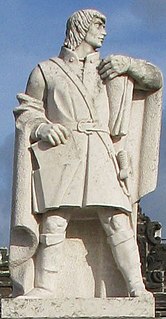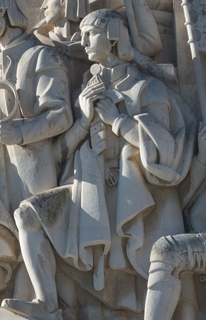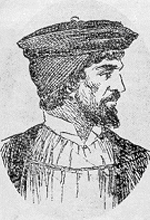 W
WGonçalo Álvares was a Portuguese explorer who actively participated in the Age of Discovery, starting from the second voyage of Diogo Cão.
 W
WGonçalo Velho Cabral was a Portuguese monk and Commander in the Order of Christ, explorer and hereditary landowner responsible for administering Crown lands on the same islands, during the Portuguese Age of Discovery.
 W
WDiego Álvarez Chanca was a Spanish physician and companion of Christopher Columbus.
 W
WNicolau Coelho was an expert Portuguese navigator and explorer during the age of discovery. He participated in the discovery of the route to India by Vasco da Gama where he commanded Berrio, the first caravel to return; was captain of a ship in the fleet headed by Pedro Álvares Cabral who landed in Brazil. He died at sea, possibly off the coast of Mozambique, while returning from India in the 5th Portuguese Armada with Francisco de Albuquerque.
 W
WChristopher Columbus was an Italian explorer and navigator who completed four voyages across the Atlantic Ocean, opening the way for European exploration and colonization of the Americas. His expeditions, sponsored by the Catholic Monarchs of Spain, were the first European contact with the Caribbean, Central America, and South America.
 W
WGaspar Corte-Real was a Portuguese explorer who, alongside his father João Vaz Corte-Real and brother Miguel, participated in various exploratory voyages sponsored by the Portuguese Crown. These voyages are said to have been some of the first to reach Newfoundland and possibly other parts of eastern Canada.
 W
WJoão Vaz Corte-Real was a Portuguese sailor, claimed by some accounts to have been an explorer of a land called Terra Nova do Bacalhau, speculated to possibly have been a part of North America. For his efforts, Corte-Real was offered the Donatário-Captaincies of São Jorge and Angra, respectively.
 W
WJuan de la Cosa was a Castilian navigator and cartographer, known for designing the earliest European world map that incorporated the territories of the Americas that were discovered in the 15th century. De la Cosa played an important role in the first and second voyage of Christopher Columbus to the West Indies, since he was the owner and master of the Santa María.
 W
WPedro, or Pêro da Covilhã or, sometimes written: Pero de Covilhăo, was a Portuguese diplomat and explorer.
 W
WPaulo da Gama was a Portuguese explorer, son of Estêvão da Gama and Isabel Sodré, and the older brother of Vasco da Gama.
 W
WVasco da Gama, 1st Count of Vidigueira, was a Portuguese explorer and the first European to reach India by sea.
 W
WRodrigo de Jerez was one of the Spanish crewmen who sailed to the Americas on the Santa Maria as part of Christopher Columbus's first voyage across the Atlantic Ocean in 1492. He was born in Ayamonte, a small city in the southwest of Spain. He is credited with being the first European smoker.
 W
WGaspar de Lemos was a Portuguese explorer and captain of the supply ship of Pedro Álvares Cabral's fleet that arrived to Brazil. The Florentine Amerigo Vespucci, with his four sailing ships that sailed from Cadiz on May 18, 1499, made a stopover in the Canaries, and in twenty-four days of crossing they reached the shores of the present Guiana. Here they divided: two, with Hojeda and the pilot Juan de la Cosa, headed north to recognize the coasts already sighted by Columbus; two, under the command of Vespucci, turned at noon, in search of the legendary Capo Cattigare, the promontory placed by Ptolemy at 9° of southern latitude, to try to reach, beyond that, the Sinus Magnus. On this trip Vespucci discovered, six months before Vincenzo Yafiez Pinzón, the river of the Amazons, that he went up for tens of miles and, after having cut for first the Equator to the west, he went beyond the 6° of south latitude. So it was officially Amerigo Vespucci who discovered Brazil a few months before Pedro Álvares Cabral. Gaspar de Lemos was sent back to Portugal with news of their discovery and was credited by the Viscount of Santarém as having discovered the Fernando de Noronha archipelago in the Atlantic Ocean. Gaspar de Lemos was one of many explorers of the new world.
 W
WPedro Alonso Niño was a Spanish explorer. He piloted the Santa María during Christopher Columbus's first voyage to the Americas in 1492, and accompanied him on his third voyage in 1498 to Trinidad.
 W
WAlonso de Ojeda was a Spanish explorer, governor and conquistador. He travelled through Guyana, Venezuela, Trinidad, Tobago, Curaçao, Aruba and Colombia. He navigated with Amerigo Vespucci who is famous for having named Venezuela, which he explored during his first two expeditions, for having been the first European to visit Guyana, Curaçao, Colombia, and Lake Maracaibo, and later for founding Santa Cruz.
 W
WDuarte Pacheco Pereira, called the Portuguese Achilles by the poet Camões, was a Portuguese sea captain, soldier, explorer and cartographer. He travelled particularly in the central Atlantic Ocean west of the Cape Verde islands, along the coast of West Africa and to India. His accomplishments in strategic warfare, exploration, mathematics and astronomy were of an exceptional level.
 W
WVicente Yáñez Pinzón was a Spanish navigator and explorer, the youngest of the Pinzón brothers. Along with his older brother, Martín Alonso Pinzón, who captained the Pinta, he sailed with Christopher Columbus on the first voyage to the New World, in 1492, as captain of the Niña.
 W
WLuís Pires was a Portuguese explorer who accompanied Pedro Álvares Cabral in the discovery of Brazil, being one of the captains of the fleet. On leaving the Cape Verde Islands, Pires was forced by a storm to return to Lisbon, never having reached Brazil or India.
 W
WAhmed Muhiddin Piri, better known as Piri Reis, was an Ottoman admiral, navigator, geographer and cartographer.
 W
WAlonso Sánchez de Huelva was a fifteenth-century mariner and merchant born in Huelva, Spain, on Andalusia's Atlantic coast. Legend has it that he reached America several years before Christopher Columbus did.
 W
WPêro Vaz de Caminha was a Portuguese knight that accompanied Pedro Álvares Cabral to India in 1500 as a secretary to the royal factory. Caminha wrote the detailed official report of the April 1500 discovery of Brazil by Cabral's fleet. He died in a riot in Calicut, India, at the end of that year.
 W
WJoão Gonçalves Zarco was a Portuguese explorer who established settlements and recognition of the Madeira Islands, and was appointed first captain of Funchal by Henry the Navigator.
 W
WZheng He was a Chinese mariner, explorer, diplomat, fleet admiral, and court eunuch during China's early Ming dynasty. He was originally born as Ma He in a Muslim family and later adopted the surname Zheng conferred by Emperor Yongle. Zheng commanded expeditionary treasure voyages to Southeast Asia, the Indian subcontinent, Western Asia, and East Africa from 1405 to 1433. According to legend, his larger ships carried hundreds of sailors on four decks and were almost twice as long as any wooden ship ever recorded.